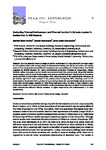Evaluating thermal environment and thermal comfort in schools located in Kashan-Iran in mid-seasons
| dc.contributor.author | Korsavi, Sepideh Sadat | |
| dc.contributor.author | Montazami, A | |
| dc.contributor.author | Zomorodian, ZS | |
| dc.date.accessioned | 2021-10-09T07:34:38Z | |
| dc.date.available | 2021-10-09T07:34:38Z | |
| dc.date.issued | 2017-01-01 | |
| dc.identifier.isbn | 9780992895754 | |
| dc.identifier.uri | http://hdl.handle.net/10026.1/18026 | |
| dc.description.abstract |
The study seeks the impact of design on thermal environment of a high school with courtyard design and of a primary school with compact design in mid-seasons in Kashan, hot and dry part of Iran, and studies students' Thermal Sensation Votes (TSV) and investigates their compatibility with Predicted Mean Vote (PMV) suggested by ASHRAE Standard 55. Indoor environmental parameters including air temperature, relative humidity, radiant temperature and air velocity were recorded under free running mode. Along with objective measurements, a total of 113 girl students aged 15-18 were surveyed three times in the high school, 59 students during April 2015 and 54 students during October 2015, collecting a total of 323 questionnaires. Moreover, 59 girl students aged 10-11 were surveyed in the primary school during May 2014, collecting a total of 172 questionnaires. Results show that Top is closer to Tout in the high school with courtyard design than in the primary school with compact design, especially in north facing classrooms where the effect of solar radiation is less. Furthermore, results of this study show that PMV model overestimates high school students' thermal sensation while overestimates children's thermal sensation at higher temperatures and underestimates it at lower temperatures. | |
| dc.format.extent | 1163-1170 | |
| dc.language.iso | en | |
| dc.rights | Attribution 4.0 International | |
| dc.rights | Attribution 4.0 International | |
| dc.rights.uri | http://creativecommons.org/licenses/by/4.0/ | |
| dc.rights.uri | http://creativecommons.org/licenses/by/4.0/ | |
| dc.title | Evaluating thermal environment and thermal comfort in schools located in Kashan-Iran in mid-seasons | |
| dc.type | conference | |
| dc.type | Conference Proceeding | |
| plymouth.volume | 1 | |
| plymouth.publication-status | Published | |
| plymouth.journal | Proceedings of 33rd PLEA International Conference: Design to Thrive, PLEA 2017 | |
| plymouth.organisational-group | /Plymouth | |
| plymouth.organisational-group | /Plymouth/Faculty of Arts, Humanities and Business | |
| plymouth.organisational-group | /Plymouth/Users by role | |
| plymouth.organisational-group | /Plymouth/Users by role/Academics | |
| dc.rights.embargoperiod | Not known | |
| rioxxterms.licenseref.uri | http://creativecommons.org/licenses/by/4.0/ | |
| rioxxterms.type | Conference Paper/Proceeding/Abstract |



